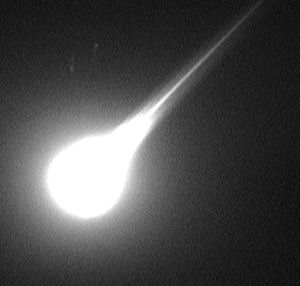New Particles in the Atmosphere, Two Non-Classical Examples
Introduction
Small particles play several very important roles in the atmosphere. They provide surfaces on which exotic chemical reactions can take place, and they act as the condensation nuclei ("seeds") on which water condenses to form ice particles and cloud droplets. Particles may also reflect visible and UV sunlight back to space (cooling the earth), and absorb outgoing infra-red radiation (contributing to the "greenhouse" effect).
For thermodynamic reasons (decreasing entropy), it is actually quite difficult to form new particles in the atmosphere from gaseous constituents. This process is known as homogeneous nucleation: a few molecules condense together to form a stable cluster (about 1 nm in size), which then becomes the building block for further growth.

Image of a large meteor burning up in the atmosphere during the Leonid meteor shower. Smoke from such events has been shown to be responsible for the production of new particles in the middle atmosphere.
Photo taken from the NASA DC-8 in 2002. Image G. Varros/NASA-ARC, http://leonid.arc.nasa.gov/
This project will examine two examples of homogeneous nucleation that occur in very different regions of the atmosphere: iodine oxide particles, which form in the marine boundary layer from iodine species that are produced biogenically in the ocean; and meteoric smoke particles, which form in the middle atmosphere from the metals and silicon oxides that ablate from meteoroids.
For both these systems, we want to follow the evolution of the particles from single molecules to particles containing about 1 million molecules (diameter about 50 nm), in order to understand what controls the rate of growth and the shapes of the particles.Preliminary work shows that the particles are fractal-like ("fluffy"), with large surface areas which often facilitate chemical reactions. For example, meteoric smoke particles may influence some of the chemistry controlling ozone in the stratosphere.
We will also examine the properties of these particles as ice condensation nuclei. Iodine oxides have recently been observed at high concentrations over coastal Antarctica, and could be a source of ice nuclei near the surface. Meteoric smoke particles are most likely the nuclei for noctilucent clouds. These ice clouds, which form around 83 km at high latitudes during mid-summer, were first observed at the end of the 19th Century. This has led to speculation that they are an early indicator of climate change in the middle atmosphere.
Finally, we will address the question of how meteoric smoke particles descend from around 80 km to the earth's surface. The particles have been detected both by capturing them with a rocket-borne instrument flying above 70 km (in this project we propose to analyze some of these captured particles), and by detecting cosmic iridium and platinum in ice cores from Greenland and Antarctica. We will use the Met Office's general circulation model to study the transport pathways during present-day conditions and during a glacial maximum, in order to interpret the ice core record over several hundred thousand years.
Objectives
1 Iodine oxides particles (IOP)
1.1 Study the formation kinetics of IxOy (R1 - R6), and the thermal stability of I2O2 and I2O4
1.2 Measure the photolysis cross section of OIO from 300 to 600 nm
1.3 Study the formation kinetics of small IxOy clusters, and their growth to large IOP (diameter = 50 nm), as a function of RH
1.4 Measure the uptake coefficient of H2SO4 on IOP, as a function of RH
1.5 Determine the properties of IOP as ice nuclei in the polar boundary layer
1.6 Develop IOP evolution models to underpin the NERC programmes RHaMBLe and COBRA.
2 Meteoric smoke particles (MSP)
2.1 Measure the kinetics of SiO + O3 and SiO2 + O (R7 and R8)
2.2 Study the formation kinetics of small Fe-Si-O particles, growth to large fractal MSP, and the effects of an external applied magnetic field
2.3 Measure the uptake coefficients of HCl, H2SO4, HNO3 and N2O5 on MSP
2.4 Determine the properties of MSP as ice nuclei for NLCs
2.5 Analyse mesospheric particles collected through the NASA project MAGIC
2.6 Model the formation and transport of MSP from the upper mesosphere to the troposphere using a general circulation model, for present-day conditions and the Last Glacial Maximum.
Project Details
This project is a NERC funded project led by Professor John Plane at the University of Leeds. The Manchester component of this project is centred around measurements of the ice nucleation properties of the particles using the ESEM instrument.